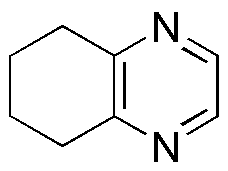5,6,7,8-Tetrahydroquinoxaline is widely utilized in research focused on:
- Pharmaceutical Development: This compound serves as a scaffold in the synthesis of various bioactive molecules, particularly in the development of new drugs targeting neurological disorders.
- Neuroscience Research: It is used in studies investigating the modulation of neurotransmitter systems, which can lead to advancements in treatments for conditions like depression and anxiety.
- Material Science: The compound is explored for its potential in creating novel materials with unique electronic properties, beneficial for the development of sensors and organic electronics.
- Chemical Synthesis: It acts as an intermediate in the synthesis of other complex organic compounds, streamlining the production processes in various chemical industries.
- Biochemical Assays: Researchers utilize it in assay development to study enzyme activities and interactions, aiding in the understanding of biochemical pathways.
Informations générales
Propriétés
Sécurité et réglementation
Applications
5,6,7,8-Tetrahydroquinoxaline is widely utilized in research focused on:
- Pharmaceutical Development: This compound serves as a scaffold in the synthesis of various bioactive molecules, particularly in the development of new drugs targeting neurological disorders.
- Neuroscience Research: It is used in studies investigating the modulation of neurotransmitter systems, which can lead to advancements in treatments for conditions like depression and anxiety.
- Material Science: The compound is explored for its potential in creating novel materials with unique electronic properties, beneficial for the development of sensors and organic electronics.
- Chemical Synthesis: It acts as an intermediate in the synthesis of other complex organic compounds, streamlining the production processes in various chemical industries.
- Biochemical Assays: Researchers utilize it in assay development to study enzyme activities and interactions, aiding in the understanding of biochemical pathways.
Documents
Fiches de données de sécurité (FDS)
La FDS fournit des informations de sécurité complètes sur la manipulation, le stockage et l’élimination du produit.
Spécifications du produit (PS)
Le PS fournit une description complète des propriétés du produit, notamment sa composition chimique, son état physique, sa pureté et les exigences de stockage. Il détaille également les plages de qualité acceptables et les applications prévues du produit.
Certificats d'analyse (COA)
Recherchez des certificats d'analyse (COA) en saisissant le numéro de lot du produit. Les numéros de lot et de lot se trouvent sur l'étiquette d'un produit, après les mots « Lot » ou « Lot de fabrication ».
Numéro de catalogue
Numéro de lot/série
Certificats d'origine (COO)
Ce certificat d'exploitation confirme le pays dans lequel le produit a été fabriqué, et détaille également les matériaux et composants utilisés et s'il est issu de sources naturelles, synthétiques ou autres sources spécifiques. Ce certificat peut être requis pour les douanes, le commerce et la conformité réglementaire.
Numéro de catalogue
Numéro de lot/série
Fiches de données de sécurité (FDS)
La FDS fournit des informations de sécurité complètes sur la manipulation, le stockage et l’élimination du produit.
DownloadSpécifications du produit (PS)
Le PS fournit une description complète des propriétés du produit, notamment sa composition chimique, son état physique, sa pureté et les exigences de stockage. Il détaille également les plages de qualité acceptables et les applications prévues du produit.
DownloadCertificats d'analyse (COA)
Recherchez des certificats d'analyse (COA) en saisissant le numéro de lot du produit. Les numéros de lot et de lot se trouvent sur l'étiquette d'un produit, après les mots « Lot » ou « Lot de fabrication ».
Numéro de catalogue
Numéro de lot/série
Certificats d'origine (COO)
Ce certificat d'exploitation confirme le pays dans lequel le produit a été fabriqué, et détaille également les matériaux et composants utilisés et s'il est issu de sources naturelles, synthétiques ou autres sources spécifiques. Ce certificat peut être requis pour les douanes, le commerce et la conformité réglementaire.


